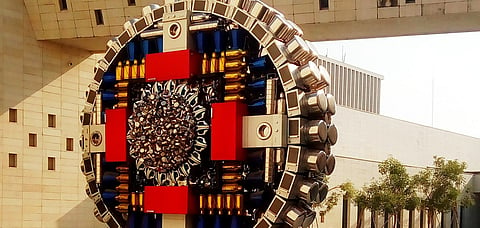
- Destinations
- Experiences
- Stay
- What's new
- Editor’s Picks
- Responsible Tourism
- CampaignsCampaigns
- Subscribe

Museums are dense repositories of stories from our past, inspiration for our present, and, when we arrive at the future, the chance for necessary reflection. On June 25, at Bihar Museum Biennale's second edition, Conflictorium's Avni Sethi, Sanskriti Museum's curator Gustav Imam, Professor Ajay Gudavarthy, and Art Historian and Professor YS Alone, joined Chinki Sinha for an engaging discussion on how museums serve as spaces for discourse and platform for voicing unspoken narratives.
The first edition of the museum Biennale, an initiative of the Bihar Museum in Patna, was held in Mumbai earlier this month. Across both editions, exploring the museum's scope in conserving stories and democratising art presented itself as the overarching theme. As a testament, the Bihar Museum itself presents a rich and poignant collection, allowing visitors to witness multiple perspectives that shaped the region's and India's history. If you are in the city, here's why you should plan a visit to the museum.
Housing History
Patna, a city rich in history and ancient civilisations, holds a tapestry of captivating tales within its land spanning over two millennia. The Patna Museum, established in 1917 and soon to mark its centenary, proudly houses the world-renowned Didarganj Yakshi, a monumental Mauryan statue that has captivated visitors for generations. However, recognising the limitations of the existing museum in terms of space and presentation, the Department of Art, Culture and Youth, State of Bihar (DACY), proposed the creation of a new museum on Bailey Road. Commonly referred to as the Jadu Ghar or "house of magic," this new institution aims to become the central focal point for celebrating the region's glorious history and unifying ancient India. To accomplish this vision, Lord Cultural Resources, the world's leading firm in museum planning, was commissioned to develop a world-class museum in Patna through a competitive bidding process.
Building upon the foundation of the Patna Museum, meticulous research and analysis were conducted on its vast collections. The decision was made to retain much of the natural history section, symbolised by a remarkable silicified tree embedded in the ground. Additionally, the new Bihar Museum plans to enhance the exhibits by exploring the modern history of Bihar, emphasising the heroic struggle for independence and the remarkable achievements of Bihar and India since gaining independence. The Chief Minister and senior officials of the Bihar State government provided valuable guidance and direction for the new Bihar Museum, which features permanent collection galleries consisting of history and an art gallery. Alongside these, dedicated spaces such as the Orientation Gallery and Special Displays showcase the artistic heritage of ancient times and highlight the tribal arts, crafts, and performing arts from different regions of Bihar. With its focus on the needs of Bihari residents, the Bihar Museum aims to foster a sense of belonging and provide an inspiring environment for children and youth to learn and progress. As a result, it has become a vibrant cultural hub and an enticing tourist destination, attracting visitors from around the world.
Remnants Of The Past
The Bihar Museum houses a diverse collection of art objects, including stone and bronze sculptures, miniature paintings, thangkas, prehistoric artefacts, anthropological items, and objects related to social history. The museum's permanent collection galleries have two main components a history gallery and an art gallery. Through its exhibited artefacts and artworks, the museum narrates the story of ancient Pataliputra and Bihar from the earliest to the 18th century.
Cataloguing and digitisation are ongoing endeavours at the Bihar Museum, aiming to facilitate proper utilisation, records, and conservation of the collections, making them accessible to authorised personnel. As the official repository of pre-1800 archaeological discoveries within the state, the museum will also house all future notable archaeological finds. To foster growth and development, the museum endeavours to expand its collection through research-based activities and potential partnerships with local, regional, and national museums and repositories. However, the museum will maintain a selective approach to collection growth, ensuring that the materials accessioned align with its criteria.
Cover photo credits Wikimedia Commons
